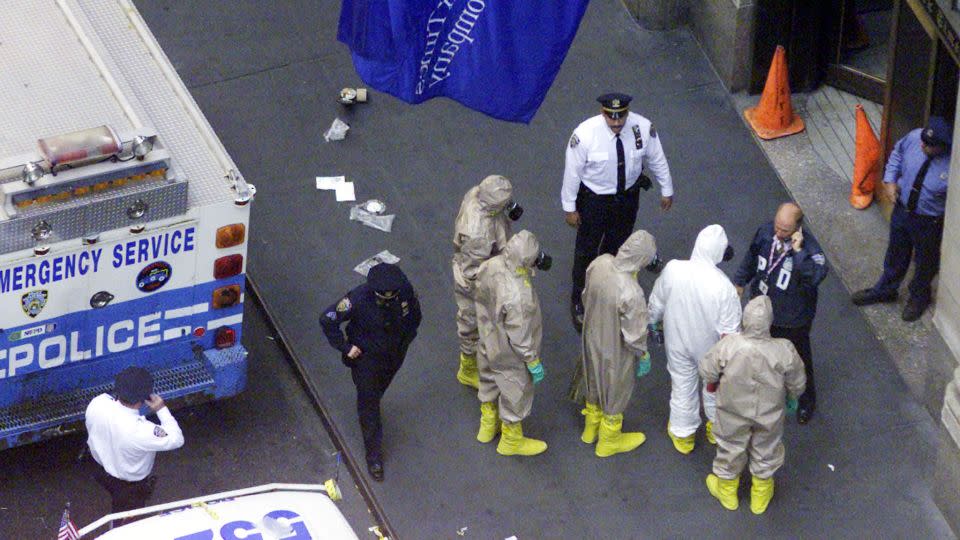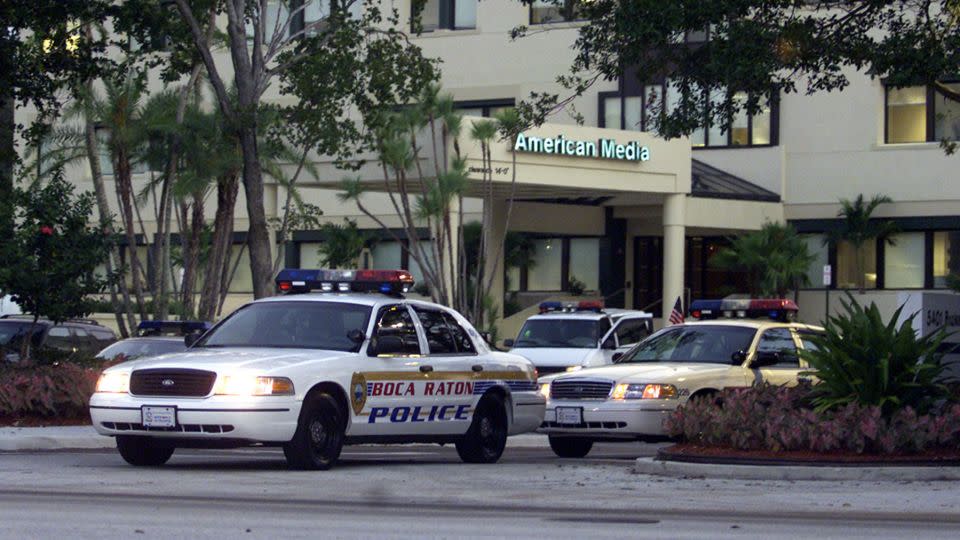Lessons from the deadly anthrax attacks of 2001
Editor’s Note: A new episode of the CNN Original Series “How It Really Happened” spotlights the terrifying anthrax attacks that followed Sept. 11, 2001, taking viewers inside one of the largest investigations in FBI history. It premieres Sunday, May 5 at 9pm ET/PT.
I had spent much of the week in a space suit.
It was March of 2001 and I was in training at the Center for Domestic Preparedness in Anniston, a little known facility operating on a former Army base in Alabama.
I had just left the New York Police Department to join ABC News as their expert on al-Qaida, Bin Laden and Terrorism. I landed in a class with 20 cops and firemen to get certified as a Weapons of Mass Destruction Technician. The “space suits” were Level A hazmat suits, with hoods and self-contained breathing apparatuses. We practiced how to operate in environments with nerve agents like sarin gas, or biological agents like anthrax.
When I completed my training, they gave me a small lapel pin in the shape of a cobra to signify I had trained in air-tight vaults with “live” deadly chemical agents and was certified.
Seven months later, I woke up struck by a most beautiful day. It was sunny, warm, and there was not a cloud in the blue sky. It was the morning of September 11, 2001.
In the days that followed, America tried to recover from events that had shaken us to our core. There were nearly 3000 dead and fears of another attack.
A new terror
Anthrax. The ABC news desk asked me to look into a Florida man who had died from anthrax poisoning. Was this terrorism? I ran down what I could, but it seemed that Robert Stevens, a photo editor at American Media near Boca Raton, FL, had been hiking on a vacation. He could have picked it up in a cave or from a dead animal. He didn’t seem like a natural target for terrorists.
And then came the flood. A week later, the letters began coming to the New York Post and ABC News. Senate Majority Leader Tom Dachle’s office got one. More than two dozen staffers tested positive for anthrax exposure. NBC News got one addressed to Tom Brokaw. His assistant had been exposed and became very ill, but recovered.
On October 12, NYPD Detective Patrick Pogan finished up a long night at the Staten Island landfill, where he sifted through the debris coming in from Ground Zero, looking for evidence or human remains connected to the hijackers or any of Pat’s many friends and partners lost at the Twin Towers. He later joined the FBI’s Joint Terrorism Task Forces squad I-41, the Weapons of Mass Destruction Unit.
I caught up with him recently. “Back then, after working at the landfill all night, I would sleep under my desk on the floor,” he recalled. “After 9/11, real sleep wasn’t a thing anymore. I was asleep for a little while and the phone rang. The supervisor asked if I could cover a lead.”
Anthrax. Another letter containing white powder had been received by Judith Miller, the New York Times’ lead reporter on WMD. Pogan says Miller told him it probably wasn’t real. “It smells like Talcum powder,” he remembers her saying.
He had two thoughts; first, I hope she doesn’t know that because she sniffed it, and second, she was probably right. He and his FBI and NYPD colleagues had responded to dozens of hoax calls that they referred to simply as ‘white powder jobs.’ Pogan took the letter to the New York City Health Department lab for testing.
The next time Pogan went back to the lab, one of the biologists looked up from the microscope and said, “Hey, glad you’re here. We were just about to call you. This stuff is real, it’s anthrax.”
“The biologist let me look through the microscope. There they were. I could see them, these little tubes on the microscope image. This was anthrax,” Pogan said, and he briefed his superiors.
“I got back in the car and I turned to John Scarbeck, the agent I worked with and said, what do you want? I got cipro (ciprofloxacin) or doxycycline in the glove compartment, pick one.” Both antibiotics are considered anthrax antidotes. “On the WMD squad you always knew exposure was a risk, so I kept these in the car,” he added.
Pogan and his team were still overwhelmed by 9/11 leads and a smoking wreck at Ground Zero, but they knew New York City was under attack again. This one wasn’t fiery, instant, and deadly on a mass scale. This one was dark, slow, insidious and like nothing we had seen before.
It also lined up with what Pogan and I had learned in our COBRA training at Anniston. This weapons grade anthrax was finely milled into tiny particles that could not be contained simply by a sealed envelope. It escaped into postal facilities where the mail was processed. It floated through the air like a deadly lottery ticket where the unlucky person who chose to take a breath while passing by. It was killing people, one at a time, day by day. Between October 5, and November 22, 2001, five people who were exposed died from anthrax poisoning.
Seeking experts
Anthrax. Saddam Hussein? Bin Laden? A lone wolf in his basement? The FBI codenamed the case “Amerithrax.” In November, the FBI released a profile developed by the Bureau’s Behavioral Science Unit saying that the anthrax killer was likely a male, a loner and might work in a laboratory. Hundreds of agents, analysts and scientists worked around the clock. For help, they turned to the US Department of Defense lab at Fort Detrick, Maryland, where anthrax expert Dr. Bruce Ivins worked.
By summer of 2002, the investigation had zeroed in on a main suspect. Search warrants were carried out at the Maryland apartment of Dr. Steven Hatfill, a bio-weapons expert who had worked for the Department of Defense as well as for governments in places like Rhodesia, now known as Zimbabwe.
The FBI swabbed Hatfil’s home and Florida storage lockers for traces of anthrax. Then they discovered he had been taking cipro. Investigators learned that Hatfill’s Easy Pass had registered road trips on the highways near the places in Maryland, and New Jersey where the anthrax letters were mailed from. Despite efforts to keep the investigation secret, Hatfill’s name came out, and he was described by Attorney General John Ashcroft as “a person of interest” in the case.

By September of 2002, I had left the news business to become the Chief of Counterterrorism for the LAPD. “White powder jobs” continued to come in, all of them hoaxes or some accidentally spilled Sweet’N Low on a conference room table. The LAPD hazmat team had reduced its response from building evacuations, blocked streets, and decontamination showers to a discreet arrival by three hazmat team members and a quick assay using specialized equipment to determine the properties of the powder. Usually within half an hour, we could say it was non-hazardous, and quietly go away. But each time I rolled on one of those jobs, I knew the anthrax killer was still out there and I wondered if they would strike again.
In August of 2002, the “person of interest,” Dr. Steven Hatfill, held a press conference declaring his innocence and filed a civil lawsuit against the Attorney General, the Justice Department and the FBI. When I left the LAPD to join the FBI as an Assistant Director in 2005, my job was to run the FBI’s outreach to the communities across the country and to serve as the Bureau’s national spokesman.
My boss, then FBI Director Bob Mueller, met regularly at the FBI’s command center with the families of the anthrax victims to update them as best he could about the case. Mueller took the Bureau’s relationship with the families very seriously. He felt we owed it to them to keep them in the loop. The families were told a good deal that was not public. I don’t believe they were ever the source of a leak about the case.
Eventually, Director Mueller changed the Amerithrax probe’s leadership. He worried that the focus on Dr. Hatfill had closed the investigation off from other suspects. Hatfill had been cleared and paid more than $2.8 million in a settlement that also included another $3 million to be paid out at $150,000 a year. Under a new inspector, the case started from scratch.

In 2008, the investigation had narrowed down to Dr. Bruce Ivins, one of the bio scientists who investigators first interviewed looking for anthrax expertise.
Ivins essentially felt that his work was underfunded and underappreciated. The Ameritrhax squad believed Ivins thought an anthrax attack right after 9/11 would result in a flood of resources to his Army bioweapons research lab.
Ivins likely knew from the FBI interviews and conversations with his lawyer that he was about to be charged as the anthrax killer, so he took an overdose and died in an apparent suicide. He was right. We had a mountain of evidence, and were going to arrest him within 48 hours.
The anthrax case is full of lessons, successes, and failures. I learned that you can train for something the way the experts think it’s going to unfold, but when it actually goes down, you may find that even the best training didn’t tell you everything about the real-world events.
I also realized how important it is to think of the victims and their families. FBI Director Mueller made it a point to develop a relationship of trust and accessibility with them. I believe that’s why they never publicly criticized the agency, which would have only made the job harder.
The final takeaway is about tunnel vision. Every investigator has to follow their gut, but only to a point. You may have the best suspect in the world, but the real suspect may be standing right next to you.
John J. Miller is the Chief Law Enforcement and Intelligence Analyst for CNN. He is a veteran award-winning journalist and experienced law enforcement and intelligence executive. Prior to joining CNN, Miller served as Deputy Commissioner of Intelligence & Counterterrorism of the New York Police Department (NYPD). He’s also held positions with the Los Angeles Police Department and the FBI.
For more CNN news and newsletters create an account at CNN.com


